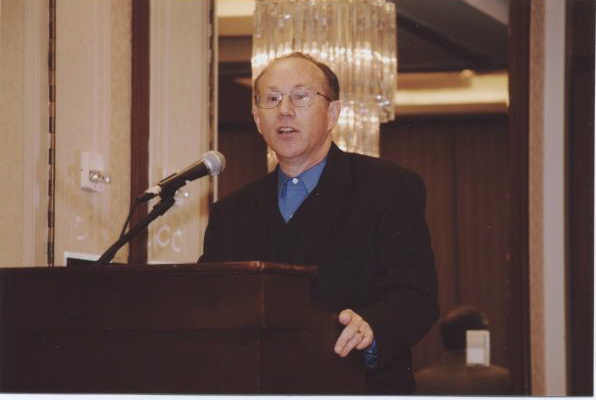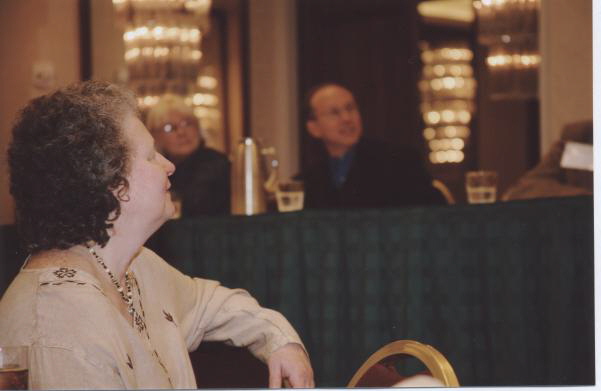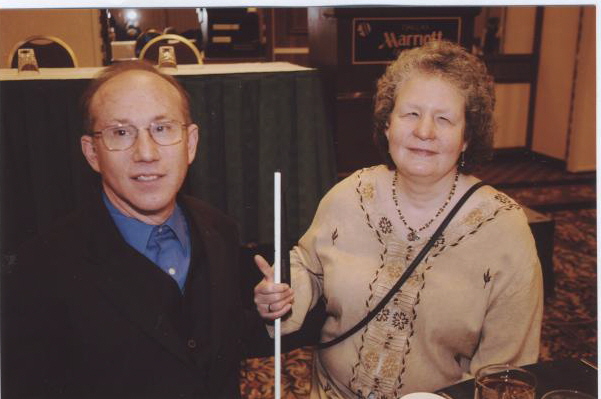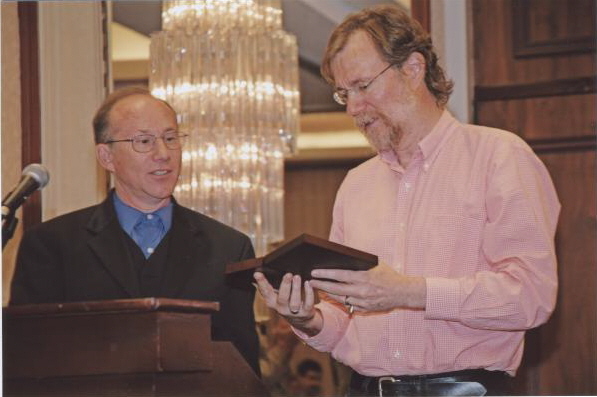


Thank you all for this great honor. Before I start, I would like to thank my wife, Caryn Navy, for the countless things she did to get our enterprise off the ground. I will list a few of these:
Now I know that most of you do not know who I am. It turns out there are some very good reasons for my obscurity.
Let's start at the beginning. I wrote computer programs for the Apple 2 computer that allowed a blind person to edit text using voice output, produce braille, and print out inkprint material. The software included a braille translator and a back translator from braille to inkprint. Around 1983, this software started to become very popular.
Remember that the Apple 2 computer came out before the IBM PC. At the time there was a furious debate as to the best direction for software development for the blind. Should work be focused on the means to access mainstream programs, or should work be focused on making unique applications that worked well for blind users?
Some people characterize this as the mainstream application versus specialized application argument. The history of the blindness field is full of its echo. Indeed, it is the basis of discussion all across the disability field. For example, we recognize the strong reluctance to adopt the braille system a century and a half ago because it looked so different from inkprint. Here is a case where the "specialized product" (braille) succeeded because of the impracticality of adopting tactile inkprint letter shapes for the blind.
For computer applications, the weight of history has been very heavy, mainstream applications have won. Specialized applications lost. By using JAWS, Window-Eyes or other access software, a blind user can surf the internet and run a vast array of mainstream applications.
But it was not always this way. When the IBM-PC first came out, it was quite difficult for a blind user to master. The early screen access programs had limitations on what text they could read back.
In 1984, Prof. Edwin Eames of Baruch College performed a telephone survey of blind microcomputer users. At the time, there was growing concern about the difficulty of helping blind persons to get the skills necessary to master the IBM-PC. He reported to me privately that virtually all successful IBM-PC users had an Apple II at home.
What I had done was make one very well constructed specialized application for the blind. The documentation was in inkprint, braille, and audio tape. Raised Dot Computing offered many services which were fairly unique. We had a monthly newsletter that offered reasonably even-handed coverage of many products in the blindness field. Our products came with very detailed interfacing notes that allowed non-technicians to hook up equipment successfully. We tried to resolve all the technical phone calls that came our way.
So, for a time, say from 1983-1989, an Apple computer and software from Raised Dot Computing solved so many problems encountered by schools needing to help their blind students produce inkprint and their staff produce braille. Part of the reason that the software was so popular was that it was written expressly for this purpose. This is the charm of specialized applications.
After 1990, the lure of mainstream applications, the desire to use the software of the wider world finally popped the Raised Dot Computing bubble. One could say that I fought a losing battle, delivering a specialized product to a world that hungered for the ultimate mainstream product. But in the process I managed to educate an entire generation of blind persons in the basics of how to use a computer to efficiently organize and prepare the text that they needed for their daily lives. I also taught them to expect software products for the blind to perform well and have a reasonably blind-friendly user interface. I always paid close attention to the needs of blind users of my software.
There is one story I have to tell. One of the first users of my very early software was Harvey Lauer of the Hines VA near Chicago. After I sent him a program disk, I got a dozen suggestions from him. It took two weeks, but I crafted a new disk which dealt with his issues. Almost immediately, I got a list of another dozen suggestions. I knew something was not quite right. So I asked him about it. He confessed to coming up with 2 dozen issues immediately, but he decided to divide the list in two to try not to discourage me when I was just starting out.
When it was time for my company to abandon the Apple 2 computer, we decided to focus our attention on braille translation. Braille Translation software is an example of a needed Specialized Application (in other words, the mainstream market was not going to produce a quality braille translation product on its own). We decided to build the ultimate braille translation software.
One key insight we had was about the two flavors of markup used in word processing programs. Some markup would describe structure as in "this is heading level 3", some markup systems would describe appearance on the page "use Helvetica bold 17 point". A braille translator would work best if everything was converted into a structure-based markup system.
We spent considerable time taking all the braille formatting rules to break them down to their simplest form. Our hope was that we could create a very intuitive braille program that would guide the user into producing high quality braille with the simplest user interface. The result was MegaDots, which we launched in 1992. It is still going strong. Duxbury Systems released a new version in 2006. I'd like to point out that MegaDots had a design team of three: Aaron Leventhal, Caryn Navy, and myself. MegaDots had a coding team that was largely Aaron working by himself.
In 1999, my company collapsed financially. The remains were purchased by Duxbury Systems. I have been working with Duxbury Systems on a wide variety of fronts ever since. Peter Sullivan and I have created "an embosser module" together. This is a dll that contains all the embosser-specific code in the Duxbury DBT product. This dll has been used by other Duxbury products, including the latest edition of MegaDots.
My most exotic project lately has been to do a preliminary analysis of the work necessary to create a braille translator for Mandarin Chinese.
Finally, let me say this about obscurity. There are many ways to be obscure. Let me give you one example. In 1983, it was possible to purchase a device called an "ETF-80" Electric Typing Fingers. It connected to a parallel port on a microcomputer and ran a series of solenoids so as to mimic the action of typing fingers on a typewriter. In an earlier era, IBM had modified some of its model D typewriters to produce braille. We added the ETF-80 as an embosser in our Apple 2 software, by keeping track of which typewriter key to press for the different contraction symbols. So, it was possible to produce braille by means of an Apple computer, Raised Dot software, a parallel port, an ETF-80 unit and a model-D IBM typewriter modified for braille. If you Google "ETF-80 Electric Typing Fingers", the only text that you get is from Raised Dot Computing literature about the braille application. So while I may be obscure, the person responsible for the ETF-80 unit is totally obscure: visible only from the moonlight glow of the ancient history of Raised Dot Computing.

